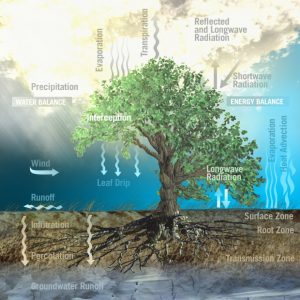12. Surface Energy Balance and Evapotranspiration
In the previous two chapters we focused on evaporation and transpiration, two processes which are major energy sinks at the land surface. In this chapter, we will directly examine the energy balance for the land surface, represented on the right side of Fig. 12‑1. We will consider the nature and fate of radiation received at the land surface, the exchange of sensible heat between the surface, the atmosphere, and the soil, and the consumption of energy (latent heat) during evapotranspiration. The surface energy balance is essentially a way of accounting for heat transfer between the land surface and its surroundings.

Heat transfer is simply energy transfer that depends on the temperatures of the objects or systems involved. Temperature is a measure of the average kinetic energy of the random microscopic movements of the molecules or particles of a substance. Temperature is also the physical quantity which determines the direction of heat transfer between two substances in thermal contact with each other. Heat is transferred from regions of higher temperature to regions of lower temperature. Viewed in this way, temperature is somewhat analogous to water potential, the physical quantity which determines the direction of water flow.

